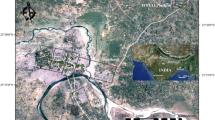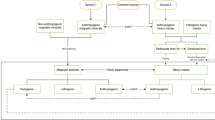Abstract
The use of mineral magnetic techniques as pollution proxy for road deposited sediment was explored using various statistical approaches. Standard techniques were adopted for measurement of mineral magnetic and geochemical parameters. The analyses of magnetic parameters revealed that the samples were dominated by ferrimagnetic minerals and multidomain grains. This implied that the magnetic fractions in the samples might be of anthropogenic origin. Results also indicate that the samples were dominated by low coercive, magnetically soft minerals. Thermomagnetic curves confirmed magnetite as the remanence bearing magnetic mineral having a Curie point temperature of ~580 °C. The strong association observed between magnetic susceptibility, susceptibility of anhysteric remanent magnetization and saturation isothermal remanent magnetization and aluminum, titanium, manganese, iron, chromium and lead demonstrated that these metals occurred as ferrimagnetic particles of technogenic origin resulting from vehicular sources. Assessment of pollution status of the road deposited sediment identified silicon and lead as the priority pollutants of concern. Generally, pollution load index was <1 (mean, 0.66 ± 0.14), indicating that the samples were not polluted in the overall, but the metals were in the buildup stage requiring constant monitoring. The sources of pollutants from principal component and cluster analyses identified the sources of pollution to be mainly from vehicular emissions such as brake linings, exhaust materials, tire wear, corroded metal parts, abrasion of lubricating oil and road construction materials. This study found that mineral magnetic techniques offer great potential as pollution proxy for soil pollution studies.






Similar content being viewed by others
References
Basavaiah N (2011) Geomagnetism: solid earth and upper atmosphere perspectives. Springer, Dordrecht
Barakat A, El Baghdadi M, Rais J, Nadem S (2012) Assessment of heavy metal in surface sediments of day river at beni-mellal region, morocco. Res J Environ Earth Sci 4(8):797–806
Basavaiah N, Blaha U, Das PK, Deenadayalan K, Sadashiv MB, Schulz H (2012) Evaluation of environmental magnetic pollution screening in soils of basaltic origin: results from Nashik Thermal Power Station, Maharashtra, India. Environ Sci Pollut Res 19:3028–3038
Carraz F, Taylor KG, Stainsby S, Robertson D (2006) Contaminated urban road deposited sediment (RDS), Greater Manchester, UK: a spatial assessment of potential surface water impacts. North West Geogr 6(1):10–19
Chan LS, Ng SL, Davis AM, Yim WWS, Yeung CH (2001) Magnetic properties and heavy metal contents of contaminated seabed sediments of Penny’s Bay, Hong Kong. Mar Pollut Bull 7(42):569–583
Crosby CJ (2012) Application of mineral magnetic measurements as a pollution proxy for urban road deposited sediment. Ph.D. thesis, University of Wolverhampton
Crosby CJ, Fullen MA, Booth CA, Searle DE (2014) A dynamic approach to urban road deposited sediment pollution monitoring (Marylebone Road, London, UK). J Appl Geophys 105:10–20
Das PK (2014) Magnetic investigations of urban pollution at Mumbai and Nashik, Maharashtra. Mineral Magnetic Method as a Pollution Proxy. Ph.D. thesis, University of Mumbai
Dlouha S, Petrovsky E, Kapicka A, Boruvka L, Ash C, Drabek O (2013) Investigation of polluted alluvial soils by magnetic susceptibility methods: a case study of the Litavka River. Soil Water Res 8(4):151–157
Evans ME, Heller F (2003) Environmental magnetism: principles and applications of Environmagnetics. Academic Press, San Diego, USA
Hakanson L (1980) Ecological risk index for aquatic pollution control. A sedimentological approach. Water Res 14:975–1001
Hu XF, Su Y, Ye R, Li XQ, Zhang GL (2007) Magnetic properties of the urban soils in Shanghai and their environmental implications. Catena 70:428–436
Kim W, Doh SJ, Park YH, Yun ST (2007) Two-year magnetic monitoring in conjunction with geochemical and electron microscopic data of roadside dust, Seoul, Korea. Atmos Environ 41:7627–7641
Loska K, Wiechula D (2003) Application of principle component analysis for the estimation of source of heavy metal contamination in surface sediments from the Rybnik Reservoir. Chemo 51:723–733
Lu SG, Bai SQ (2008) Magnetic characterization and magnetic mineralogy of the hangzhou urban soils and its environmental implications. Chin J Geophys 51(3):549–557
Lu SG, Bai SQ, Xue QF (2007) Magnetic particles as indicators of heavy metals pollution in urban soils: a case study from the City of Luoyang, China. Geophys J Int 171:603–612
Maher BA, Moore C, Matzka J (2008) Spatial variation in vehicle-derived metal pollution identified by magnetic and elemental analysis of roadside tree leaves. Atmos Environ 42(2):364–373
Muller G (1981) The heavy metal pollution of the sediments of neckars and its tributaries: an inventory. Chem Zeitung 105:157–164
NPC (2006) National Population Commission, Nigeria. http://www.nigeriamasterweb.com/Nigeria06CensusFigs.htm. Accessed 20 Jan 2012
Obaje NG (2009) Geology and mineral resources of Nigeria, vol 120. Lecture notes in earth sciences. Springer, Berlin. doi:10.1007/978-3-540-92685-61
Panaiotu CG, Necula C, Panaiotu CE, Axente V (2005) A magnetic investigation of heavy metals pollution in Bucharest. In: Ionel I (ed) Sustainability for humanity and environment in the extended connection field science-economy-policy, Scientific reunion of the special program of Alexander von Hombold Foundation concerning the reconstruction of the South Eastern Europe, Editura Politehnica, Timisoara (ISBN 973-625-204-3), 83–86
Pourret O, Lange B, Bonhoure J, Colinet G, Decree S, Mahy G, Seleck M, Shutcha M, Faucon MP (2016) Assessment of soil metal distribution and environmental impact of mining in Katanga (Democratic Republic of Congo). Appl Geochem 64:43–55
Ramasamy V, Suresh G, Venkatachalapathy R (2009) Magnetic susceptibility of the Ponnaiyar River Sediments, Tamilnadu, India. Glob J Environ Res 3(2):126–131
Reis AR, Oliveira AI, Pinto JPM, Parker A (2014) Occurrence and distribution of metals in urban road deposited sediments in a small urban area: preliminary results of a study in Vila Real city, northern Portugal. Comun Geol 101(Especial II):1055–1058
Reyes BA, Bautista F, Goguitchaichvili A, Contrras JJM, Owen PQ, Carvallo C, Battu J (2013) Rock magnetic properties of topsoils and urban dust from Morelia (>800,00 inhabitants), Mexico: implications for anthropogenic pollution monitoring in Mexico’s medium size Cities. Geofis Int 52–2:121–133
Robertson DJ, Taylor KG, Hoon SR (2003) Geochemical and mineralogical magnetic characterization of urban sediment particulates, Manchester, UK. Appl Geochem 18:269–282
Simeonov V, Einax J, Tsakovski S, Kraft J (2005) Multivariate statistical assessment of polluted soils. Cent Eur J Chem 3(1):1–9
Singh AK, Hasnain SI, Banerjee DK (2003) Grain size and geochemical portioning of heavy metals in sediments of the Danoder River—a tributary of the lower Ganga, India. Environ Geol 39:90–98
Turekian KK, Wedepophl KH (1961) Distribution of the elements in some major units of the Earth’s Crust. Geol Soc Am Bull 72:175–192
Venkatachalapathy R, Rajeswari V, Basavaiah N, Balasubramanian T (2013) Environmental magnetic studies on surface sediments: a proxy for metal and hydrocarbon contamination. Int J Environ Sci Technol. doi:10.1007/s13762-013-0355-4
Warwer M, Magiera T, Ohja G, Appel E, Kusza G, Hu S, Basavaiah N (2015) Traffic related pollutants in roadside soils of different countries in Europe and Asia. Water Air Soil Pollut 226:216. doi:10.1007/s11270-015-2483-6
Yongming H, Peixuan D, Junji C, Posmentier ES (2006) Multivariate analysis of heavy metal contamination in urban dusts of Xi’an, Cental China. Sci Total Environ 355:176–186
Yunker MB, Macdonald RW, Vingarzan R, Mitchell RH, Goyette D, Sylvestre S (2002) PAHs in the Fraser River basin: a critical appraisal of PAH ratios as indicators of PAH source and composition. Org Geochem 33:489–515
Zhang XY, Qiao Lin F, Wong F, Mike TF, Feng XL, Wang K (2009) Identification of soil heavy metal sources from anthropogenic activities and pollution assessment of Fuyang County, China. Environ Monit Assess 154:439–449
Zhu Z, Sun G, Bi X, Li Z, Yu G (2015) Identification of trace metal pollution in urban dust from kindergartens using magnetic, geochemical and lead isotopic analyses. Atmos Environ 77:9–15
Acknowledgements
The research formed part of a doctoral investigation supported by the Taraba State University Tertiary Education Trust Fund for which the first author expresses thanks. We sincerely wish to appreciate the Department of Science and Technology (DST), India, and the Indian Institute of Geomagnetism (IIG), Mumbai, for permission to use the facilities at the Environmental Magnetism Laboratory. Gratitude is also extended to Dr. P. K. Das for critical review and comments.
Author information
Authors and Affiliations
Corresponding author
Additional information
Editorial responsibility: M. Abbaspour.
Rights and permissions
About this article
Cite this article
Kanu, M.O., Basavaiah, N., Meludu, O.C. et al. Investigating the potential of using environmental magnetism techniques as pollution proxy in urban road deposited sediment. Int. J. Environ. Sci. Technol. 14, 2745–2758 (2017). https://doi.org/10.1007/s13762-017-1356-5
Received:
Revised:
Accepted:
Published:
Issue Date:
DOI: https://doi.org/10.1007/s13762-017-1356-5




